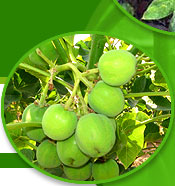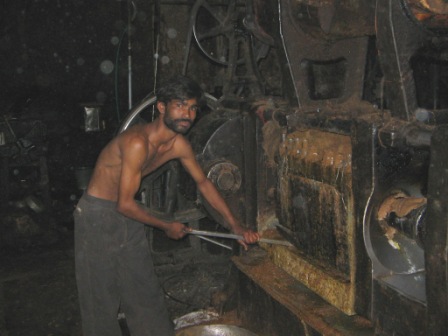 |
|
|||
|
|
| |
 |

The yield of the seed over a defined area determines the capacity of the extraction to be set up. The extraction unit capacity is based on the amount of seed feedstock introduced into it. The seed yield, in turn, determines other key variables of production capacity of the extraction units and hence determines the fixed and variable costs of the extraction stage Preparation of Seeds The ripe fruits are plucked from the trees and the seeds are sun dried. They are decorticated manually or by decorticator. To prepare the seeds for oil extraction, they should be solar heated for several hours or roasted for 10 minutes. The seeds should not be overheated. The process breaks down the cells containing the oil and eases the oil flow. The heat also liquefies the oil, which improves the extraction process. Oil can be extracted from the seeds by heat, solvents or by pressure. Extraction by heat is not used commercially for vegetable oils. The oil from Jatropha seeds can be extracted by three different methods. These are mechanical extraction using a screw press, solvent extraction and an intermittent extraction technique viz. soxhlet extraction. Purification of Oil
Sedimentation This is the easiest way to get clear oil, but it takes about a week until the sediment is reduced to 20 - 25 % of the raw oil volume. Boiling with water The purification process can be accelerated tremendously by boiling the oil with about 20 % of water. The boiling should continue until the water has completely evaporated (no bubbles of water vapour anymore). After a few hours the oil then becomes clear. Filtration Filtration of raw oil is a very slow process and has no advantage in respect of sedimentation. It is not recommended. Oil extraction can be more effectively carried out by the improved expellers by the following methods: Method 1: Prepressing of seeds lightly can precede oil milling. This results in higher capacity; lower power consumption, lower wear & tear and maintenance. The oil recovery is lower in this case. Under the National At the Biotech Park-Lucknow, a 1.0-ton/day oil expeller has been installed for extraction of oil from jatropha seeds. The disadvantages of expellers are listed as follows:
Raw oil extraction can be improved using better extraction techniques which can enhance the economics of biodiesel production. SOLVENT EXTRACTION IS RECOMMENDED FOR BY- PRODUCTS Together with the oil, by-products of the production are:
STORAGE During storage, oil is likely to react with atmospheric oxygen and other environmental factors, and this may lead to a change in oil quality, particularly increase in FFAs (free fatty acids). The quality of oil may get deteriorated during prolonged storage; generally oxidative and hydrolytic rancidity occurs due to enzymes, air, and moisture. Jatropha seeds and seed oil quality may get deteriorated on storage due to bacteria, moles, enzymatic degradation, oxidation, and hydrolysis. Therefore, it is important to understand the effect of storage conditions on quality of oil in order to optimize the economically viable storage conditions for storage of oil. Further, following parameters are important for vegetable oil to be used for bio-diesel production.
BIO-OIL PLANT Specification of model oil-cum- biodiesel plant being supplied by us
Electric motor driven Bio-oil mill: (1) Installation is very easy. In 5 to 8 hours time, you can install the machinery and start the production of oil. Ready foundation frames will be supplied and you have to simply place the expeller and electric motor on it and connect it by V belt Foundations of any machines in ground not required. (2) When mill is running it is very silent. There is no noise. (3) It becomes very compact unit as there is no intermediate counter shaft. It occupies less space and you can shift the machinery very easily from one place to another as and when required. (4) You should have 3 phase 415 volts +10% electric power connection or electric power generator. (5) It is complete project and you need not purchase anything locally. (6) @ 33%, you can produce 1000 liter oil from this oil mill in 24 hours. For business enquiry, kindly contact Business Development Officer Centre for Jatropha Promotion Tele: +91 141 2335839 E-mail: jatrophacurcas@gmail.com
|
© 2004- 2024 ABC-Advanced Biofuel center ,, All Rights Reserved |

 JATROPHA OIL MAKING
JATROPHA OIL MAKING